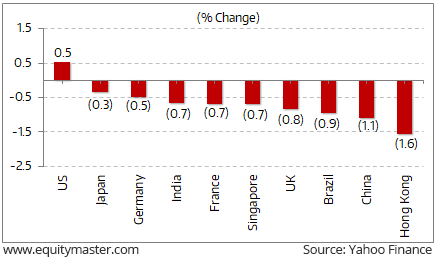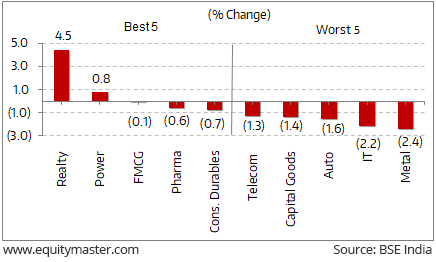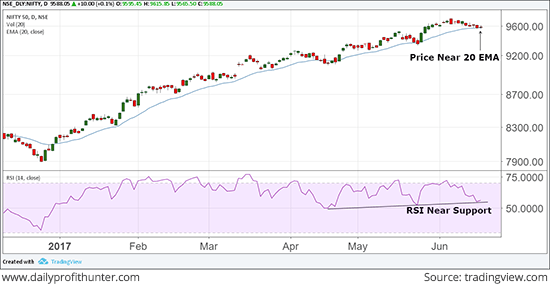- Home
- Todays Market
- Indian Stock Market News June 17, 2017
Global Share Markets Feel the Pressure of Trump Probe, Fed Hike Sat, 17 Jun RoundUp
Global financial markets ended the week on a negative note. This is on the back of soft US economic data, a relatively hawkish Federal Reserve and a media report that US President Donald Trump is being investigated by a special counsel for possible obstruction of justice.
Despite inflation coming in below the Fed's target, the central bank said it would raise the benchmark interest rate by 25 basis points. The Fed also provided greater detail about how it would unwind its massive balance sheet. The US markets were up 0.5% for the week gone by.
Following the Fed's rate hike, China's central bank left interest rates for open market operations unchanged on Thursday. Earlier on Thursday, The People's Bank of China injected a net 90 billion yuan into the financial system via open market operations. China's benchmark one-year lending and deposit rates have remained unchanged since October 2015. The stock market in China was down by 1.1% for the week gone by.
Back in Europe, the Bank of England (BOE) left rates at 0.25% and bond purchases at £435 billion. The BOE's decision was the first since the UK's general election resulted in a hung parliament. The stock market in the UK was down by 0.8% for the week gone by.
The Bank of Japan kept monetary policy steady on Friday and upgraded its assessment of private consumption for the first time in six months, signalling its confidence in an export-driven economic recovery that is gaining momentum. The Nikkei fell 0.3% for the week gone by.
Crude prices stumbled near a six-week low as doubts grew over OPEC's ability to cut oil supplies, weighing on stocks worldwide and adding to worries over the resilience of sectors most geared to economic growth.
Key World Markets During the Week

Back home, the Indian indices closed marginally lower over the week. The market continued to consolidate due to lack of major triggers to support the up move. The BSE Sensex was down by 0.7% for the week. Midcap and Smallcap stocks outperformed the frontline indices to gain 0.04% and 2.3%, respectively.
BSE Indices During the Week

Now let us discuss some key economic and industry developments during the week gone by.
In the latest development, the Goods and Services Tax Council has decided to cut the rate on household goods and other essential items, raising the threshold for the scheme that requires lesser compliance and approving another key set of rules relating to audit and accounts.
Accordingly, the Council reduced tax rates on 66 items including cashew nuts, packaged foods such as sauces and pickles, agarbatti, insulin, school bags, children's coloring books, cutlery, and some tractor components. The Council has also reduced the tax rate on cinema tickets costing Rs 100 or less. The Council also decided to increase the limit under the composition scheme from Rs 5 million to Rs 7.5 million. The compensation scheme was introduced for small business that would struggle to comply with the various requirements of GST.
In our view, GST promises to transform India into a single common market and many sectors are subject to benefit immensely from the transition.
If you want to dig deeper into the practical implications of GST, we strongly recommend you download Vivek Kaul's free report, What the Mainstream Media DID NOT TELL YOU about GST
In other news, the Maharashtra government has announced a loan waiver for farmers. The state government has decided to form a committee to decide the criteria for debt relief.
Soon after the announcement, the farmer groups called off their protests which they have been agitating for the past ten days. The key demands made by agitating cultivators in Maharashtra included a minimum support price for all farm produce, 100% subsidy on drip irrigation equipment, better facilities for storage and transport of crops, etc. However, the key demand made by them was the loan waiver.
The above development is followed by Uttar Pradesh government's recent farm loan waiver of Rs 307 billion. One shall note that the Uttar Pradesh government's farm loan waiver has also set a precedent of sorts with farmers from Tamil Nadu, Karnataka, Madhya Pradesh, and Rajasthan protesting for farm loan waivers from the government.
Our big-picture expert Vivek Kaul explains it in his Diary:
- The economist Alan Blinder in his book After the Music Stopped writes that the 'central idea behind moral hazard is that people who are well insured against some risk are less likely to take pains (and incur costs) to avoid it'.
This basically means that once the farmer sees a loan being waived off today, he will wait for elections in the future for the newer loans he takes on to be waived off as well. Essentially, he will see little incentive in repaying loans that he takes on in the future.
And the above situation is evident today. The recent farm loan waiver spoils credit discipline and sets the wrong precedent.
In news about the economy. According to data released by the Central Statistics Office (CSO), retail inflation as measured by the Consumer Price Index (CPI) sunk to 2.18% in May, its lowest since the Centre began measuring it on a nationwide basis in 2012.
CPI was even slower than the 2.99% seen in April, the previous record low.
The fall to record lows may put pressure on the Reserve Bank of India (RBI) to change its policy stance to accommodative from neutral at present. The RBI, which kept its key lending rate unchanged last week, has warned of a looming inflation threat over the next 6-12 months, leaving the door ajar for an interest rate hike in 2017-18. A lower inflation rate can indicate a slowdown in demand and weaker economic activity. In May 2016, CPI-based retail inflation grew 5.8%.
Meanwhile, industrial production rose at a slower pace in April, raising demands for a rate reduction by the RBI. The latest data released on Monday showed that industrial production expanded by 3.1% in April, compared to 3.8% in March and 6.5% a year ago, as mining and electricity sector witnessed a slowdown.
In the news from banking sector. Finance Minister Arun Jaitley said that the Reserve Bank of India (RBI) is drawing up a list of debtors with bad loans that need to be resolved under the insolvency law.
He further said that there are already about 81 cases filed under the IBC and 18 of these have been initiated by financial creditors. On subdued loan growth, Jaitley noted that banks are making their best efforts.
Mr Jaitley had just reviewed the quarterly performance of state-run lenders and financial institutions. The finance minister has on various occasions said that the problem of bad loans is not systemic but limited to 30-50 accounts.
The minister is going to meet heads of public sector banks to discuss the issue of non-performing assets (NPAs) and the steps being taken by them to expedite the recovery of bad loans that have crossed Rs 6 trillion.
Movers and Shakers During the Week
| Company | 9-Jun-17 | 16-Jun-17 | Change | 52-wk High/Low |
|---|---|---|---|---|
| Top Gainers During the Week (BSE Group A) | ||||
| JAIPRAKASH ASSO. | 12.34 | 14.87 | 20.5% | 17/7 |
| GMR INFRA | 16.95 | 19.45 | 14.7% | 20/10 |
| GUJ.MINERAL DEV. | 142.45 | 155.8 | 9.4% | 157/68 |
| AUROBINDO PHARMA | 608.65 | 652.65 | 7.2% | 895/504 |
| J&K BANK | 83.6 | 89.6 | 7.2% | 92/55 |
| Top Losers During the Week (BSE Group A) | ||||
| VIDEOCON INDUSTRIES | 28.55 | 22.2 | -22.2% | 115/22 |
| LANCO INFRATECH | 2.83 | 2.35 | -17.0% | 6 / 2' |
| BHUSHAN STEEL | 76.55 | 70.25 | -8.2% | 103/37 |
| MPHASIS LTD | 641.85 | 602.65 | -6.1% | 654/425 |
| IPCA LABS | 501.15 | 471.7 | -5.9% | 656/435 |
Some of the key corporate developments in the week gone by.
In the news from telecom sector. As per an article in the Economic Times, bankers have told the government that telecom companies are on the verge of defaulting their loans. This, they say, is because competitive pressures, especially after the launch of Reliance Jio in September last year, have created a severe financial stress on the business dynamics of the industry.
One shall note that Indian telecom players are facing the brunt on the back of Reliance Jio's aggressive pricing strategy, as can be seen in the chart below. To catch up with the competition, many players have started offering similar services. But the aggressive pricing has dented the overall health of these telecom companies.
Moving on to the news from stocks in information technology sector. As per an article in Livemint, Wipro Ltd is yet to finalize the date for issuing bonus or stock dividend to the holders of its American Depository Receipts (ADRs). ADRs are witnessing steep fluctuations in pre-market trading on the New York Stock Exchange (NYSE).
ADRs are instruments denominated in US dollars and the underlying shares are that of a foreign company. According to reports, the exchange has suspended trading in Wipro ADRs. The clarification came after its US-listed shares slumped nearly 49% to US$5.35 in premarket trading. The IT company's board of directors has fixed 14 June as the record date to determine eligible shareholders entitled to receive the bonus equity shares/stock dividend. In April, the company announced the issue of bonus shares in 1:1 ratio and said that its board would also consider a proposal for buyback of shares around July.
Moving on to news from pharma sector. Dr Reddy's Laboratories share price finished the trading day up by 1.4% after it was reported that the company has received Establishment Inspection Report (EIR) from the USFDA for its active pharmaceutical plant (API) at Miryalaguda indicating the successful closure of the agency's audit.
Miryalaguda plant is one of three facilities that received a warning letter from the USFDA in November 2015 for violation of good manufacturing facilities. After a re-inspection of the unit in February this year, the US drug regulator had issued Form 483 with three observations relating to lapses in quality. The regulatory issues have affected the Hyderabad-based pharma major's earnings as new product approvals in the US from the three units were held back. The US is the biggest market for the company. In 2016-17, consolidated revenue declined 9% on year to Rs 140.80 billion, while net profit fell 40% to Rs 12.03 billion.
Moving on to news from paints sector. Berger Paints India is planning to diversify into new home decor business besides its core product paints. The company will be seeking shareholders nod to pave the way to venture into new businesses.
The company is considering the business opportunities available in various areas relating to home decor, construction industry and adhesive and will leverage its manufacturing and marketing strength.
Moving on to news from stocks in the oil and gas sector. State-owned oil firms Indian Oil Corp IOC, Bharat Petroleum Corp Ltd BPCL and Hindustan Petroleum Corp Ltd HPCL have signed an agreement to jointly set up the world's largest refinery and petrochemical complex in Maharashtra at an estimated cost of US$ 40 billion.
IOC will be the lead partner with a 50% stake while HPCL and BPCL will take 25% stake each. IOC's management said that the refinery will have an accompanying mega petrochemical plant, and would include an aromatic complex, naphtha cracker and polymer complex.
The refinery will produce petrol, diesel, LPG, ATF and feedstock for making petrochemical that are basic building blocks in plastic, chemical and textile industries. India has a refining capacity of 232 million tonnes, which exceeded the demand of 194.2 million tonnes in 2016-17 fiscal. The entire refinery will include three crude units of 20 million tonnes each and will take five-six years for completion after land acquisition and all clearances.
And here's an update from our friends at Daily Profit Hunter...
The Nifty 50 Index ended the week on a negative note. On Monday, it opened gap down and continued to trade in a downtrend throughout out the week. The selling was due to a weak trend overseas. Finally, on Friday, the index recovered a bit but ended the weekly session down 0.83%.
As we mentioned in an earlier note, the Nifty formed a bearish engulfing candlestick pattern on the daily chart. This is a short-term reversal pattern that signaled a minor correction. The RSI indicator formed a negative divergence, which also indicated a correction. The index did correct - 80 points from last Friday's closing.
We mentioned that the correction might drag the index towards its 20-day exponential moving average (EMA), which is acting as good support at every minor correction since January 2017. The RSI indicator is also near its previous low, which might act as a support.
If the 20 EMA is able to provide support once again, the index might resume its uptrend. On the flip side, we might see short-term weakness if the index slips below the moving average. You can read the detailed market update here...
Will the Index Resume Its Upmove?

For information on how to pick stocks that have the potential to deliver big returns, download our special report now!
Read the latest Market Commentary


Equitymaster requests your view! Post a comment on "Global Share Markets Feel the Pressure of Trump Probe, Fed Hike". Click here!
Comments are moderated by Equitymaster, in accordance with the Terms of Use, and may not appear
on this article until they have been reviewed and deemed appropriate for posting.
In the meantime, you may want to share this article with your friends!